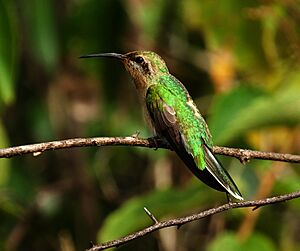Tepui goldenthroat facts for kids
Quick facts for kids Tepui goldenthroat |
|
|---|---|
 |
|
| Conservation status | |
| Scientific classification | |
| Genus: |
Polytmus
|
| Species: |
milleri
|
 |
|
| Synonyms | |
|
|
The Tepui goldenthroat (Polytmus milleri) is a tiny, colorful hummingbird found in parts of Brazil, Guyana, and Venezuela. It belongs to a group of hummingbirds called the Polytminae, sometimes known as "mangoes" because of their bright colors.
Contents
About the Tepui Goldenthroat
What's in a Name?
The Tepui goldenthroat was once in its own special group called Waldronia. Later, scientists decided it fit better with other hummingbirds in the Polytmus group. It's the only species of its kind within that group.
Appearance and Size
The Tepui goldenthroat is a small bird, about 11 to 12 centimeters (4.3 to 4.7 inches) long. That's about the length of your hand!
- Male birds weigh between 4.5 and 6.1 grams (0.16 to 0.22 ounces).
- Female birds are a bit lighter, weighing 4.1 to 5 grams (0.14 to 0.18 ounces).
Males have shiny bronze-green feathers on their backs and sparkling green feathers underneath. Their tails are green with a wide white band at the bottom and white tips. Around their eyes, they have a dark gray area with white stripes above and below.
Females are smaller than males. Their undersides are dull white but covered with many golden-green spots, especially on their chest. Young birds look like the adults but have soft, buff-colored edges on their head feathers.
Where They Live
Habitat and Location
The Tepui goldenthroat lives only on special flat-topped mountains called tepuis. These mountains are found in southern and southeastern Venezuela, and a little bit into western Guyana and northern Brazil.
On these isolated mountains, the birds live at the edge of cloudforests and in scrublands. They prefer areas with scattered trees, usually at high elevations between 1,300 and 2,200 meters (4,265 to 7,218 feet) above sea level.
Tepui Goldenthroat Behavior
Movement and Travel
These hummingbirds usually stay in one place. However, after they have their babies, some might move to different elevations on the mountains.
How They Find Food
The Tepui goldenthroat is a "trap-line" feeder. This means it flies a regular path, visiting many different flowering plants to drink their sweet nectar. They also catch insects while flying and pick up spiders from plants and rocky spots.
Reproduction and Nests
Tepui goldenthroats usually breed in May and June. They build a cup-shaped nest using fine plant fibers. They often decorate the outside of their nests with lichen, which helps them blend in.
- Nests are typically placed in the fork of a shrub branch.
- They are usually built low to the ground, about 0.5 to 1 meter (1.6 to 3.3 feet) high.
- Females lay two eggs.
- The eggs hatch after about 15 to 16 days.
Their Calls
When the Tepui goldenthroat is looking for food, it makes a "loud series of 'tsit' or 'tizzie' notes."
Conservation Status
The IUCN (International Union for Conservation of Nature) has listed the Tepui goldenthroat as a species of "Least Concern." This means they are not currently in danger of disappearing. However, scientists don't know exactly how many of these birds there are or if their numbers are changing. They are considered uncommon in some areas but can be common in others within their limited home range.


